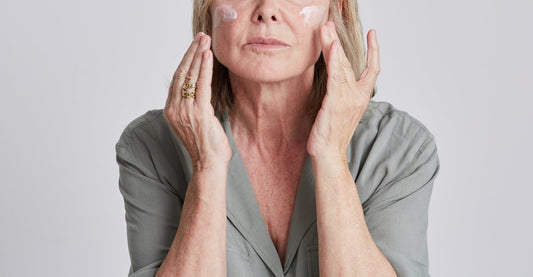You likely know the symptoms of a urinary tract infection (UTI) all too well. Urgency, frequency and burning with urination are the hallmark symptoms of a UTI, and if you’ve had one you know it’s not fun. Urinary tract infection symptoms can start gradually or come on suddenly, sending you running to the pharmacy or the gynecologist for evaluation and treatment. Left unchecked and untreated, a simple UTI can lead to a kidney infection or worse, such as hospitalization for sepsis.
UTIs are common, with more than 60% of women experiencing one in their lifetime. It’s also common for women to experience more than one UTI — many may report recurrent infections. Familiar risk factors for UTIs in women include poor bathroom hygiene habits, holding in urine for prolonged periods, sitting around in a wet bathing suit and even sexual activity. But there’s a lesser-known factor that can lead to UTIs, and it’s tied to a natural event that all women will experience. In this article we’ll discuss urinary tract infection causes during menopause, common UTI symptoms in women, and potential options for treating and preventing UTIs during menopause and beyond.
What Causes UTIs in Women During Menopause?
There are several urinary tract infection causes that may become more prevalent during perimenopause into menopause. Declining estrogen levels during menopause can lead to more delicate and less elastic vaginal and vulvar tissue. This is known to be a chronic and progressive issue. The changes associated with estrogen decline are broad; so much so that the term “genitourinary syndrome of menopause” (GSM) is now used to more broadly describe genital changes and related symptoms of vaginal dryness, pain during intercourse, irritation and bladder discomfort that can accompany menopause. Quite simply, the tissue around the urethra (where you urinate from) is not spared from this hormonal change. The peri-urethral tissue becomes prone to micro-abrasions (little cuts) during intercourse, allowing bacteria to migrate to the bladder. UTIs are more common during menopause for this reason, in addition to changes in the vaginal microbiome, which also occur during this time.
Common UTI Symptoms in Women
UTIs may seem like they’re more prevalent during menopause due to the impact of estrogen decline on vaginal and vulvar tissues as well as in tissues surrounding the urethra. But if you’re curious about what to specifically look for if you’re suspicious of an infection, there are some clear symptoms to be aware of.
While several symptoms of UTIs could be confused with other bladder health issues, such as urinary incontinence or overactive bladder, there are hallmark symptoms that can signal that what you are dealing with is indeed an infection.
Common UTI symptoms in women include:1
- Pain or burning when you urinate, also called dysuria
- Fever or fatigue
- An intense urge to urinate
- Frequency of urination
- Pressure in your lower pelvis
- Urine that smells bad or looks cloudy or reddish
- Blood in the urine
- Pain in your back or side below the ribs
It’s important to note that if left untreated, UTIs may progress into a more severe infection that can spread upward to the kidneys. Kidney infections are often associated with fevers and upper back pain – which is often limited to one side or the other. Kidney infections may also be associated with nausea and vomiting. These types of infections should absolutely be treated urgently, as an untreated kidney infection can cause bacteria to enter the blood, which is called sepsis, and requires hospitalization and aggressive treatment.2
Diagnosing a UTI
If you’re experiencing typical UTI symptoms, check-in with your healthcare provider. In some instances, treatment will be offered empirically based on suspicion. Lab testing is often helpful, especially for recurrent infections. Tests can include:3
- Urine Culture: A “clean catch” urine sample will confirm if an overgrowth of bacteria is present; it will also identify the type of bacteria and suggest antibiotic sensitivities to guide treatment.
- Urinalysis: A “clean catch” urine sample can also denote the presence of blood cells and other markers of infection, to help guide treatment.
Treating a Urinary Tract Infection
UTIs are caused by bacterial overgrowth. A course of antibiotics is usually recommended for treating a urinary tract infection. For a simple, uncomplicated UTI, a short course of antibiotics is often prescribed. Antibiotic selection is based on specific culture results and bacterial sensitivities.
Common antibiotics for UTIs include:4
- Amoxicillin
- Cephalosporins
- Trimethoprim/sulfamethoxazole
- Nitrofurantoin
Although some women may start feeling better before they complete their antibiotic course, completing the course prescribed is advised.
How to Prevent Urinary Tract Infections During and After Menopause
The best way to address a UTI is to prevent it from occurring in the first place. Some tips to consider for preventing UTIs in menopause, include:
- Always urinating before and after sex if you are prone to UTIs. This mechanically cleanses bacteria from the urethral opening, minimizing infection risk and potentially preventing UTIs in menopause.
- Taking a concentrated cranberry supplement. Proanthocyanins or PACs, naturally found in cranberries, are theorized to make the bladder more slippery to E. Coli, a common UTI causing bacteria.
- Incorporating a probiotic supplement geared towards vaginal health might also help to prevent a UTI during menopause. Select studies suggest that a probiotic geared towards vaginal health can optimize the vaginal microbiome and may help to prevent the recurrence of infection; more research is needed, however.5
- Hydrating adequately and urinating regularly. Avoid holding the urine for prolonged periods. Also get out of wet workout gear or wet bathing suits in a timely manner as bacteria thrive in moist, dark environments.
- Managing vaginal dryness can also help to prevent UTIs during menopause. Regular use of a vaginal moisturizer will help to keep the genital tissue more elastic and supple and less prone to abrasion during intercourse. Bonafide’s Revaree® is made with a super moisturizer known as hyaluronic acid, a naturally occurring molecule in the body that can retain up to 1000x its weight in moisture. This makes it an effective, hormone-free option for relief. A good lubricant, used on demand during sex, can also help.
Remember, vaginal changes due to menopause can be chronic and progressive if not managed proactively, and UTIs are most definitely related. The good news? In most cases they are preventable with simple measures!
Resources:
- https://medlineplus.gov/urinarytractinfections.html
- https://www.urologyhealth.org/urology-a-z/u/urinary-tract-infections-in-adults
- https://my.clevelandclinic.org/health/diseases/9135-urinary-tract-infections
- https://my.clevelandclinic.org/health/diseases/9135-urinary-tract-infections
- https://www.ncbi.nlm.nih.gov/pmc/articles/PMC6134985/










Comments
Post commentI’ve been using Revaree for 3 years once a week for vaginal dryness and occasional uti’s. I am a breast cancer survivor and cannot use a product containing estrogen. Revaree works.
Thank you Bonafide for striving to help women
I wouldn’t be without this product! There’s nothing more important than to stay lubricated. My plan is to continue using this product for the years I have left!
After 2 UTIs in under 6 months my doctor suggested estradiol cream as a remedy for vaginal dryness and to help with UTIs. I’m 72 and still sexually active and it was becoming extremely painful. The OTC moisturizers just weren’t doing the trick.
Then comes the estradiol cream…ok it did work on the vaginal dryness but OMG the side effects: bloating, cramps and the sorest nipples I’ve had since I had a cracked nipple 45 years ago nursing my oldest child.
I checked with my doctor and he said, NOT a problem, try the Revaree. No weaning off the estradiol cream either. YAY! So today I’m ordering my first subscription of Revaree. And hopefully goodbye to UTIs.
Great article. I appreciate all the attention given to a time in a women’s life that is difficult but not much is talked about. I uses Revaree weekly. I am a breast cancer survivor so it has been tremendously helpful since I cannot take hormones. Keep up the great products and articles!!
I started Revaree after many UTI’s and vaginal dryness. I used things over the counter and was not happy with the results. I choose not to use hormonal products. I have been very happy with the results. I asked my urologist for something that did not have anything to offer. So I searched on line and found Bonafide. Very happy with the product. Thank you!